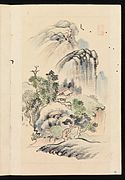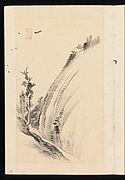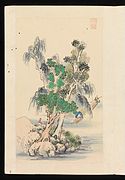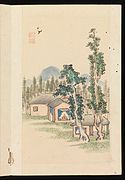Kuwayama Gyokushu
Kuwayama Gyokushū ( Japanese 桑山玉洲 , actual first name: shisan ( 嗣燦 ), other artist name : Chōudō ( 聴雨堂 ) Kakusekien ( 鶴跡園 ) Kasetsudō ( 珂雪堂 ) Myoko Kōji ( 明光居士 ); born 1746 in the province of Kii (today Wakayama Prefecture ); died May 17, 1799 ) was a Japanese painter of the Nanga direction of the Edo period .
life and work
Kuwayama Gyokushū was born the son of Kuwayama Shōchō ( 桑 山 昌 澄 ), a wealthy entrepreneur in Wakayama who ran a ship business. Gyokushū took over his father's company, but later switched to farming and focused on reclaiming new land. He spent the first half of his life doing these things. He later began to paint and wrote a number of good books on painting, such as the Gyokushū gashū ( 玉 洲 画 趣 ) and the Kaiji higen ( 絵 事 鄙 言 ).
Gyokushū began to paint without instruction, following the realistic style of Shen Quan . He met Noro Kaiseki , who also came from Wakayama. He later studied under Ike no Taiga and familiarized himself with Nanga painting.
His best works include the painted sliding doors ( 襖 絵 , Fusuma-e ) with the title “Fuji Hakone” ( 富士 ・ 箱根 ) and the screen “Mount Nachi” ( 那 智 山 橋柱 巌 図 屏風 ) in the temple Nensei-ji ( 念 誓 寺 ) in Wakayama.
Pictures from "Gaen" ( 雅園 )
literature
- Tazawa, Yutaka: Kuwayama Gyokushū . In: Biographical Dictionary of Japanese Art. Kodansha International, 1981. ISBN 0-87011-488-3 .
- Laurence P. Roberts: Gyokushu . In: A Dictionary of Japanese Artists. Weatherhill, 1976. ISBN 0-8348-0113-2 .
Web links
| personal data | |
|---|---|
| SURNAME | Kuwayama, Gyokushu |
| ALTERNATIVE NAMES | 桑 山 玉 洲 (stage name, Japanese); Kuwayama Shisan (real name); 桑 山 嗣 燦 (real name, Japanese) |
| BRIEF DESCRIPTION | Japanese painter |
| DATE OF BIRTH | 1746 |
| PLACE OF BIRTH | Wakayama |
| DATE OF DEATH | May 17, 1799 |
| Place of death | Kii Province (now Wakayama Prefecture ) |








